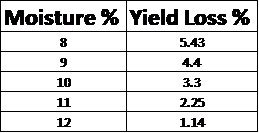AGRONOMICSUPPORT
YOU CAN TAKETO THE FIELD
The Heat is On: How Early Harvest Conditions Impact Soybean Moisture
It’s been a year.
Mother Nature cranked up the heat and dialed down the rain across much of the U.S. this growing season. Before much of the corn crop even stepped onto the stage, many soybean fields were already soaking up the sun, basking in their lead role.
As harvest season rolls in, the combines are firing up and soybeans are donning their yellow-tinted attire.
That means it’s time to talk about moisture.
Moisture during harvest can be the one thing that ensures a bounty in your bins and a boost in your bank account… or not.
Moisture content can be your yield story's unsung hero or silent villain. You want to shoot for 13-15% as you start harvesting a field. When beans are too dry, your yield drops and beans drop out of pods as you roll through the field with the combine.
When they’re too wet, you’re faced with several other issues.
Moisture Matters
When soybeans are too wet at harvest, they're like sponges holding excess moisture. This can increase the risk of fungal growth, reduce the quality of your beans and cause issues with storage. Fungi love moisture; if they reside in your beans, you can say “hello” to moldy, damaged crops and “goodbye” to a nice harvest check.
On top of that, wet beans can also spell disaster for your yield. Here’s how:
Weight loss: Moist beans mean more weight. Sounds like a good thing, right? Not exactly. You're paying for water with wet beans—essentially hauling around extra, non-profitable pounds.
Shrinkage: You sell your soybeans based on weight. Higher moisture content means more drying and higher gas bills. Plus, beans shrink as they dry, resulting in fewer bushels to sell.
Poor quality: High moisture levels can impact the quality of your soybeans and potentially lead to lower market prices. And no one wants that.
Of course, your soybeans can also be too dry. So what moisture level should you shoot for when you fire up the combine?
The Perfect Moisture Level
In general, the sweet spot for harvesting soybeans is 13-15% moisture. Beans within this range store well and are less prone to issues like mold.
Plus, if you dip below that and deliver them too dry, you’re potentially looking at a noteworthy yield loss.

Check out this data table pulled from a study by the University of Nebraska. Even with the high-yielding soybean varieties available these days, delivering dry beans can really sink your final yield
Here’s what the data looks like in real life: your beans are making 100 bushels per acre. You suffer a 4% loss because you deliver them at around 9% moisture—that’s a loss of four bushels per acre. If those beans bring in $13 per bushel, you're looking at a hefty $52 loss per acre.
That sound you hear is your wallet shrieking in pain.
But keep this in mind: the ideal moisture level can vary depending on your specific situation, local climate and storage capabilities. The key is to find a balance that minimizes drying costs while maintaining bean quality.
Need some advice? Your reliable partner on the LG Seeds agronomy team can help you determine the ideal moisture level for your specific situation.
Managing Moisture for Maximum Yield
So, how can you manage soybean moisture to ensure maximum yield? Here are some tips:
Regular monitoring: Keep a close eye on moisture levels as harvest approaches. Test multiple areas of your fields to get a clear picture of the overall moisture content. Consider harvesting while a few leaves still cling to the plant—you might find the beans are drier than you initially thought.
Timely harvest: When beans are at the proper moisture level, get out there. A timely harvest can help you preserve yield and avoid over-drying costs. Tip: when about 95% of bean pods show that tan hue, you’ve probably reached maturity.
Proper storage: If you can't get your beans to the desired moisture level in the field, ensure you have adequate storage facilities to dry them safely. And here's a fun (and helpful) fact: the moisture emanating from the damp beans at the bottom of the bin can work its magic, rehydrating any dry beans resting at the top of the pile.
The Bottom Line (Literally)
For soybean farmers, moisture isn't just about weather patterns—it's about the bottom line and money in the bank.
Moisture impacts quantity and quality. Quality helps secure the best market prices, and managing soybean moisture at harvest can be the difference between a bountiful yield and a disappointing loss.
So, as the combines roll out, monitor your moisture. And if you are looking for some expert advice, give your reliable partner a call.






Agronomy Team